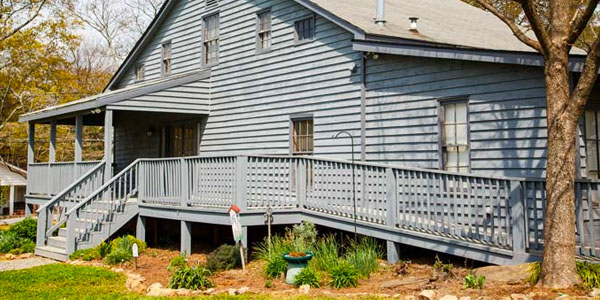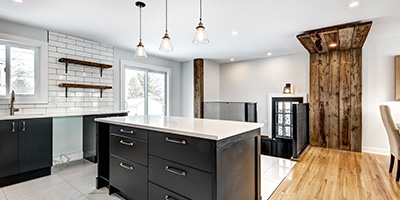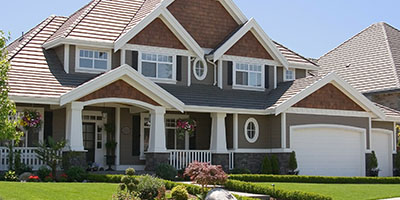Essential Home Remodeling Projects for People With Disabilities

Essential Home Upgrades for Acessibility
Your home should be a place of comfort. Yet, if you or a loved one is one of the 40 million Americans living with a disability, building a truly comfortable home can be daunting. Even before you get estimates for remodeling your home around a disability, there is the exhaustive process of identifying all the changes your home needs to accommodate your needs.
Fortunately, there are a variety of resources and experts out there who can help you during the planning process. We’ll get you started by guiding you through the most common home modifications for disabled needs, as well as a few of the most well-known organizations that can provide assistance.
Where Should You Start When Remodeling for Accessibility?
Before starting, it’s important to remember that there’s no one-size-fits-all solution for home modifications, as Caitlin Hoff, health and safety investigator for ConsumerSafety.org explains:

“Even within the same root cause, two people can experience different limitations; a good example of this situation is the birth injury Cerebral palsy (CP) which can affect two people in completely different ways causing different disabilities.
“One person with CP may struggle with fine motor skills in their hands or arms, while another relies completely on a wheelchair for mobility. Home modifications need to adapt to the individual person not the disability as a whole.”
Caitlin Hoff, Health and Safety Investigator, Consumer Safety
Keeping that in mind, there are a few key areas of your house you should focus on:
- Bathrooms: These rooms are high-risk areas for slips and falls, making them a central focus of any remodel for a homeowner or family member with a disability.
- Kitchen: Updating your kitchen is one of the most important rooms to consider when remodeling for a handicap or disability to ensure all appliances and surfaces are usable.
- Entrances & Stairways: Entryways and stairways are especially important to make sure you or your loved one can easily enter and move around the house themselves.
Within these three areas, there are any number of changes you can make to suit your specific needs. Below are a few of the most common features incorporated into home remodels that focus on accessibility.
Essential Bathroom Modifications
- Walk-in showers: Showers that are level with the bathroom floor are not just wheelchair accessible, but also safer to use. This how-to shows the steps to converting a bathtub to a walk-in shower.
- Grab bars: Handles placed next to bathroom fixtures, including the shower, greatly improve accessibility.
- Lowered sinks & countertops: Another way to help those with a wheelchair reach sinks, countertops and cabinet space.
- Widening doorways & floor space: Wider door frames and added floor space enable those with wheelchairs or mobility devices to easily enter and exit the room.
Looking for more ways to create a safer bathroom? Check out our Bathroom Safety Guide for Seniors!
Essential Kitchen Modifications
- Lowered countertops & cabinets: Using lower countertops and cabinets with pull-out drawers will make finding and using cookware simple. The ideal height for countertops is typically 28 to 34 inches tall, though should be customized for the user.
- Touch-sensitive faucets: These types of faucets are very helpful for those with limited use of their hands or arms.
- Lowering power outlets: Relocating your power outlets will make plugging and unplugging appliances a lot easier. If your budget and home layout permits, this is also a good idea for the other rooms in your home.

Essential Mobility Modifications
- Wheelchair ramp: One of the most common exterior modifications, a custom-built wheelchair ramp will allow you or your loved one a greater degree of independence.
- Chair lift/elevator: Depending on the scope of your project, you may decide to install a chair lift or in-home elevator. The former typically does not require remodeling to install and is the more budget-friendly option. However, an in-home elevator provides the added benefit of being able to move a wheelchair between floors with minimal effort.
Planning on aging in place?
Here are a few more remodeling ideas to make your home comfortable throughout your retirement.
How Much Does Remodeling for a Disability Cost?
Cost is the biggest factor for any home remodel, and remodeling to accommodate a handicap or disability is no different. “On average a person with a disability will spend anywhere from $5000-$9,000 on a general home remodeling project,” says Hoff. “Usually, these numbers are focusing on people with limited mobility who require modifications to allow wheelchair mobility.”
Due to these high costs, there are numerous grants and financial assistance programs available to help reduce the cost of making your home accessible. Here are a few of the most well-known organizations that offer funding or direct assistance for building an adapted home or modifying an existing one:
Home Improvement Grants & Assistance for Homeowners With a Disability
- The US Department of Veterans Affairs: Offers two types of grants for veterans, one for construction of a specially adapted home and another for modifying a currently owned home.
- Rebuilding Together AmeriCorps: Helps families throughout the country modify their homes to accommodate the needs of family members with disabilities.
- The Rural Housing Repair and Loans: Provides loans and grants for low-income homeowners ages 62 and over.
- National Council of State Housing Agencies: Offers a comprehensive directory of state housing agencies and their offices to find local housing assistance programs near you.
Where Should I Start Looking for Contractors?
If you’re looking to hire your own contractor without outside assistance, you should make sure you hire a professional with experience in remodeling homes for accessibility. A good place to start is by searching for nearby members of Accessible Home Improvements of America, a nationwide network of independent living solutions providers.
Outside of the AHIA, you should look for contractors with the Certified Aging-in-Place Specialist, or CAPS, designation. This is a certification granted by the National Association of Home Builders to those professionals who have received training in the design and installation of home accessibility solutions.
There are any number of ways to make your home more accessible, but any large-scale remodeling or modifications you make should always be tailored to fit you or your loved one’s specific needs. Though the process may appear intimidating at the outset, remember that there are resources and professionals nearby to lend you a hand.


